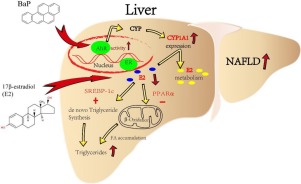当前位置:
X-MOL 学术
›
Toxicol. Lett.
›
论文详情
Our official English website, www.x-mol.net, welcomes your
feedback! (Note: you will need to create a separate account there.)
In vitro and in vivo approaches for identifying the role of aryl hydrocarbon receptor in the development of nonalcoholic fatty liver disease
Toxicology Letters ( IF 2.9 ) Pub Date : 2020-02-01 , DOI: 10.1016/j.toxlet.2019.10.010 Xiang-Yu Zhu 1 , Hong-Guang Xia 1 , Zhi-Hao Wang 1 , Biao Li 1 , Hai-Yan Jiang 1 , Da-Lang Li 1 , Rui Jin 1 , Yong Jin 1
Toxicology Letters ( IF 2.9 ) Pub Date : 2020-02-01 , DOI: 10.1016/j.toxlet.2019.10.010 Xiang-Yu Zhu 1 , Hong-Guang Xia 1 , Zhi-Hao Wang 1 , Biao Li 1 , Hai-Yan Jiang 1 , Da-Lang Li 1 , Rui Jin 1 , Yong Jin 1
Affiliation

|
Nonalcoholic fatty liver disease (NAFLD) is a chronic hepatic disease associated with the excessive accumulation of lipids in the liver. Premenopausal women are protected from the liver metabolic complications of obesity compared with body mass index (BMI)-matched men. This protection may be related to estrogen's ability to limit liver fat accumulation. Aryl hydrocarbon receptor (AhR), a novel regulator of NAFLD, may be an important target for regulating estrogen homeostasis. In present study, we used benzo[a]pyrene (BaP), a classic and potent ligand of AhR, to activate AhR pathway causes overexpression of the estrogen-metabolizing enzyme cytochrome P450 1A1 (CYP1A1) and affects the expression of important genes involved in hepatic lipid regulation. BaP induces CYP1A1 expression through AhR signaling and inhibits the protective effect of 17β-estradiol (E2) on hepatic steatosis, characterized by triglyceride accumulation, and markers of liver damage are significantly elevated. The expression of adipogenic genes involved in the hepatic lipid metabolism of sterol regulatory element-binding protein-1c (SREBP-1c) was increased compared with that in the control group. Furthermore, the mRNA and protein levels of peroxisome proliferator-activated receptor alpha (PPARα), which is involved in fatty acid oxidation, were significantly reduced. Taken together, our results revealed that the steatotic effect of AhR is likely due to overexpression of the E2 metabolic enzyme CYP1A1, which affects the estrogen signaling pathway, leading to the suppression of fatty acid oxidation, inhibition of the hepatic export of triglycerides, and an increase in peripheral fat mobilization. The results from this study may help establish AhR as a novel therapeutic and preventive target for fatty liver disease.
中文翻译:

鉴定芳烃受体在非酒精性脂肪肝发展中的作用的体外和体内方法
非酒精性脂肪性肝病 (NAFLD) 是一种慢性肝脏疾病,与肝脏中脂质的过度积累有关。与体重指数 (BMI) 匹配的男性相比,绝经前女性免受肥胖引起的肝脏代谢并发症的影响。这种保护作用可能与雌激素限制肝脏脂肪堆积的能力有关。芳基烃受体 (AhR) 是 NAFLD 的新型调节剂,可能是调节雌激素稳态的重要靶点。在本研究中,我们使用苯并 [a] 芘 (BaP),AhR 的经典和有效配体,激活 AhR 通路,导致雌激素代谢酶细胞色素 P450 1A1 (CYP1A1) 过度表达,并影响参与其中的重要基因的表达。肝脏脂质调节。BaP 通过 AhR 信号传导诱导 CYP1A1 表达,并抑制 17β-雌二醇 (E2) 对肝脏脂肪变性的保护作用,以甘油三酯积累为特征,肝损伤标志物显着升高。与对照组相比,参与甾醇调节元件结合蛋白-1c(SREBP-1c)肝脏脂质代谢的脂肪生成基因表达增加。此外,参与脂肪酸氧化的过氧化物酶体增殖物激活受体α (PPARα) 的 mRNA 和蛋白质水平显着降低。总之,我们的结果表明,AhR 的脂肪变性作用可能是由于 E2 代谢酶 CYP1A1 的过度表达,影响雌激素信号通路,导致脂肪酸氧化受到抑制,抑制甘油三酯的肝脏输出,并增加外周脂肪动员。这项研究的结果可能有助于将 AhR 确立为脂肪肝疾病的新型治疗和预防靶点。
更新日期:2020-02-01
中文翻译:

鉴定芳烃受体在非酒精性脂肪肝发展中的作用的体外和体内方法
非酒精性脂肪性肝病 (NAFLD) 是一种慢性肝脏疾病,与肝脏中脂质的过度积累有关。与体重指数 (BMI) 匹配的男性相比,绝经前女性免受肥胖引起的肝脏代谢并发症的影响。这种保护作用可能与雌激素限制肝脏脂肪堆积的能力有关。芳基烃受体 (AhR) 是 NAFLD 的新型调节剂,可能是调节雌激素稳态的重要靶点。在本研究中,我们使用苯并 [a] 芘 (BaP),AhR 的经典和有效配体,激活 AhR 通路,导致雌激素代谢酶细胞色素 P450 1A1 (CYP1A1) 过度表达,并影响参与其中的重要基因的表达。肝脏脂质调节。BaP 通过 AhR 信号传导诱导 CYP1A1 表达,并抑制 17β-雌二醇 (E2) 对肝脏脂肪变性的保护作用,以甘油三酯积累为特征,肝损伤标志物显着升高。与对照组相比,参与甾醇调节元件结合蛋白-1c(SREBP-1c)肝脏脂质代谢的脂肪生成基因表达增加。此外,参与脂肪酸氧化的过氧化物酶体增殖物激活受体α (PPARα) 的 mRNA 和蛋白质水平显着降低。总之,我们的结果表明,AhR 的脂肪变性作用可能是由于 E2 代谢酶 CYP1A1 的过度表达,影响雌激素信号通路,导致脂肪酸氧化受到抑制,抑制甘油三酯的肝脏输出,并增加外周脂肪动员。这项研究的结果可能有助于将 AhR 确立为脂肪肝疾病的新型治疗和预防靶点。











































 京公网安备 11010802027423号
京公网安备 11010802027423号